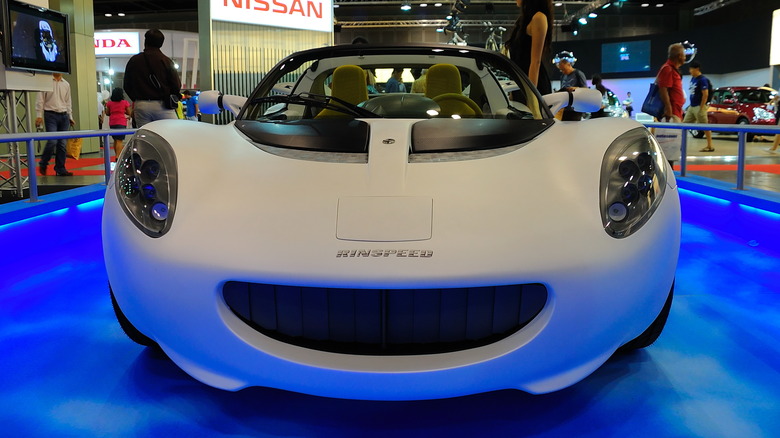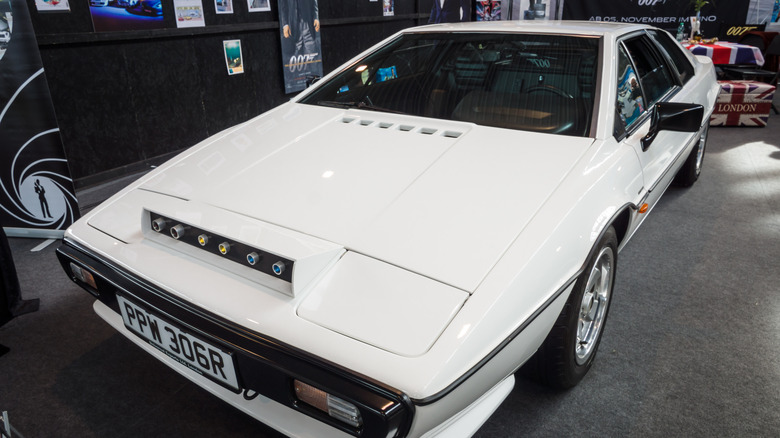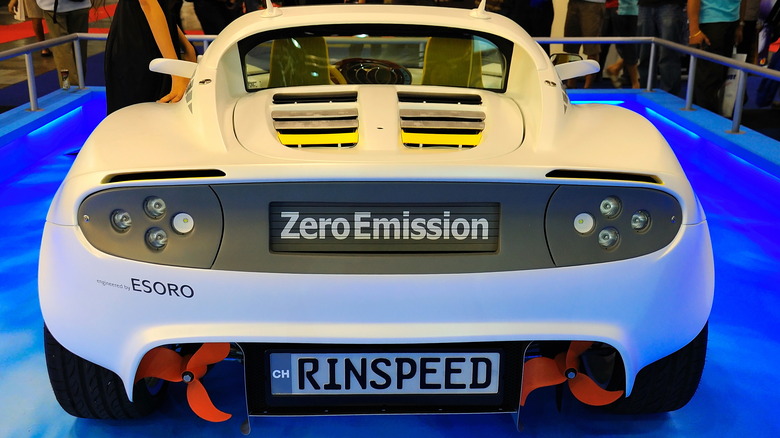Here's How Rinspeed Made A James Bond Car Into A Reality
For some of us, technology is a necessity of modern life. If you've ever dragged an older relative into the 21st century by providing them a smartphone, Kindle, Smart TV (which they surely needed a little help with), or similar, you'll know this all too well. Of course, technology is more of a way of life for others, and for such people, James Bond is undoubtedly an inspiration.
The iconic agent with the License to Kill across 27 movies has wielded various gadgets. From the legendary Golden Gun to the peculiar tear gas-emitting parking meter from "Goldfinger" (it's little surprise that this one didn't make it very far off the drawing board), 007, his allies, and his foes have had access to some of the greatest spy gear in movie history. This extends, of course, to the kinds of vehicles he's driven.
In 2023, of course, the Lotus Esprit (the S1 first released in 1975) isn't the most futuristic vehicle, but Bond's classic Esprit had a unique feature: it doubled as a submarine. "The Spy Who Loved Me" was released in 1977 and featured some rather dramatic car chases in which Bond escaped beneath the water's surface. Fantastical as the idea is, Rinspeed later developed a concept car that could do precisely this.
The introduction of the remarkable Rinspeed sQuba
As any driver knows, water is a natural enemy of cars. A simple rainstorm can adversely affect visibility, but the dangers increase exponentially regarding flooding. The AA reports that a tiny amount of water (an egg cup full) can be sufficient to ruin a vehicle's engine and that 32% of people killed in floods die in cars. How was Bond's water-defying Lotus Esprit filmed in the 1970s, before CGI trickery? Several Esprit bodies were used for the scenes, including the one and only "Wet Nellie" (as it was known during the making of the film): a custom-built convertible submarine/Esprit.
Despite its impracticality, the idea enraptured auto enthusiasts watching the movie. The notion of a sports car that could hit the water's surface, "transform" into a submarine, and speed off into the depths was (and remains) incredibly exciting. Finally, in 2008, Rinspeed presented their concept car, the sQuba, to the world.
"For three decades I have tried to imagine how it might be possible to build a car that can fly under water. Now we have made this dream come true," Rinspeed's Frank M. Rinderknecht proudly stated. The sQuba was unveiled at March 2008's Geneva Motor Show, an elegant design that boasted of being able to navigate water and do so in style. There is no mention of a production timeline, should one ever emerge.
How did the sQuba work?
The sQuba, Rinspeed goes on, is powered by a pair of jet drives and a trio of motors rather than a conventional engine. Whether traveling on the road or under the water, this system's performance isn't compromised. Esoro of Switzerland built the machine, and cutting-edge (for 2008) technology, such as lithium-ion batteries and carbon nanotubes, is incorporated into its design. This keeps the vehicle lightweight and maneuverable, not to mention very green indeed: "The Swiss are among the world's pioneers in the area of hydropower. The 'sQuba's' filling station is the water reservoir," Frank M. Rinderknecht reported.
The process is extraordinary yet simple: driver and passenger breathe underwater via SCUBA equipment, and the vehicle is submerged by allowing water into the cabin. For safety reasons, the cabin is not fully enclosed. As CAR Magazine noted in a 2009 review of the model, the foam-laden body of the vehicle floated so well that its propellers were needed to get under the water. Still, it seemed to move elegantly and effectively once there. At a reported maximum of 75 mph on the road, it performs adequately in both modes.
The sQuba is the very definition of a niche vehicle. Nonetheless, a concept car that could achieve, as Rinspeed put it, stable "flight at a depth of 10 meters" was an intriguing innovation at the very least.


